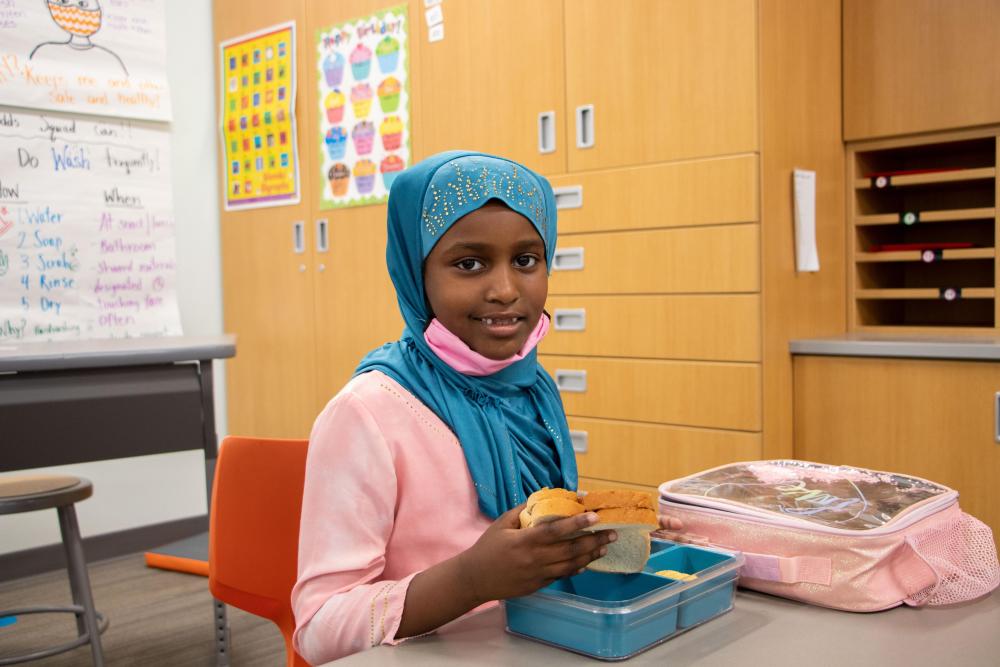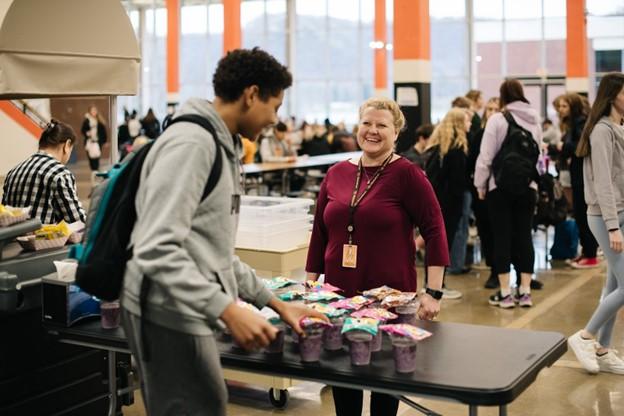
Why Schools Across Minnesota Are Essential to Ending Child Hunger
Right now, in every county in Minnesota, children are experiencing hunger. In fact, children account for more than one third of the people served by our trusted community partners. We know that meeting kids and families where they are is an effective way to combat hunger, and schools have an important role to play when it comes to connecting families to reliable, healthy foods.
With summer months fast approaching, schools will continue to play a vital role to ensure that kids have access to meals even when school is not in session. In Winona, Jennifer Walters has some very creative ideas to get meals to where students are each and every day. And she does that with a big, orange school bus.
As the district’s Nutrition Director, Jennifer leaned on her community connections to buy and refurbish an old school bus, turning it into Winona’s now infamous Lunch Bus. During the summer months in 2020 and 2021, the Lunch Bus delivered free meals to various schools, parks, the public library and even the community pool – places students already know and are likely to be – ensuring that the day’s lunch and following day’s breakfast were easily accessible to all.

Federal Covid-era waivers allowed the Lunch Bus to distribute hundreds of thousands of meals to anyone 18 years of age or younger (not just Winona Area Public Schools students). Although these waivers will end with this school year, Jennifer and her staff know that meals will still be needed. They plan to utilize the USDA’s Summer Food Service Program (SFSP) to continue serving free meals this summer. The response has been overwhelmingly positive, and Jennifer hopes Minnesota’s legislators will change policy to make free meals for all students permanently available.
“We have to do it,” says Jennifer of free meals for all. She adds, “The people I talk to say, ‘Hey Jen, we are so thankful that the meals are free this year because everything has gotten a little bit more expensive and that’s just something we don’t have to worry about.’”
SCHOOLS ARE VITAL COMMUNITY HUBS
In communities all over Minnesota, schools serve a vital role as community hubs. They provide a safe space for students and their families, while also providing basic services.
In Moorhead, the school district has stepped up in practical ways to provide services to a growing number of students experiencing homelessness. Amy Riccio-Galde is Moorhead’s brand new homeless liaison. She was hired to dream up creative ways to serve the district’s estimated 225 students experiencing homelessness. She does so by listening, advocating and constantly experimenting.
“I said, ‘I’d really like to start a school [food pantry], partly because schools are the hub,” says Amy. She knows that some families experiencing homelessness also lack reliable transportation, making trips to the food shelf difficult. By partnering with Great Plains Food Bank, Amy successfully opened the district’s first in-school food shelf, stocked with canned goods, dairy, proteins, fresh fruits and vegetables, and essential personal care items.
Recently, the district also piloted a free delivery service. Utilizing funds from the United Way, they hire DoorDash drivers to deliver grocery orders from the food shelf straight to families, free of charge. The burgeoning program has proven a success and Amy hopes to expand deliveries to more families. With a close-knit network of contacts throughout the community of Moorhead, Amy hopes more and more innovative programs and partnerships will emerge to chip away at food insecurity.
“This is such a solvable problem,” says Amy. “And that’s why I’m like, ‘Everyone just get on the same page, because we all want the same thing.’”
Across the state in the similarly-sized community of Minnetonka, Mary Davis and Joel Barron are currently experiencing food insecurity.
Mary and Joel describe themselves as best friends and each other’s chosen family. As single moms, they have combined households to save on costs like rent and utilities. While the move helped save them money, it also moved them physically further from the White Bear Lake school district where their kids are enrolled. As the 2021-2022 school year began, Mary, Joel and their kids collectively decided to continue distance learning, putting them too far away to enroll in the district’s meal delivery option. In lieu of school meals, they relied even more heavily on resources like Pandemic-EBT – a USDA program that provided temporary emergency nutrition benefits directly to kids. When eligibility rules changed, parents like Mary and Joel who opted to continue distance learning, were not able to participate.
“[Pandemic-EBT] helped because it taught [my son] a little responsibility, because he enjoyed being able to pick his own food,” says Mary, “but it was just the whole thing of being excited about it. And then once it stopped, certain foods had to stop and it started going back to what I can get and what I can afford to make sure we can get through the whole month.”
Around the time Pandemic-EBT ended for Mary and Joel, the COVID-era Child Tax Credits also stopped. For Mary to ensure funds lasted through the month, she reverted to buying cheaper, less nutritious foods.
“He’s eating stuff that wouldn’t keep his body healthy and maintained, but it’s just cheaper,” says Mary. “And of course, I’m going to go with the cheaper route to make sure he can eat all month.”
Mary and Joel have both taken out loans to pay for basic expenses, like food and household items. Joel has also made the unimaginable decision to miss meals to make sure her kids have enough to eat. Mary and Joel want other parents experiencing food insecurity to know that they are not alone. While they encourage parents to act as their own advocates, they also know first-hand the mental and emotional toll self-advocacy can take on already overwhelmed parents. They are calling on legislators for broader, systems-level changes.
SYSTEMS-LEVEL THINKING
A well-rounded, systems-level approach to solving food insecurity requires strategic thinkers – like Rachel Stoll. Put simply, Rachel’s job at Winona Health is to improve people’s lives. Collaborating with community health workers throughout Winona, Rachel and her team support families in a wide variety of ways. They are also working toward becoming a certified HUB model provider, which would allow them to bill health insurance when addressing social determinants of health.
“Instead of being a fee-for-service model,” Rachel explains, “it’s an outcomes-based model. So if one of our community health workers is able to support a family from being food insecure to having food security, then their health insurance would pay us to have gotten that done and have documented that. So it’s a really cool collaboration because it’s health insurers or payers acknowledging the truth, that if someone doesn’t have food or transportation or appropriate, safe housing, they will end up in the emergency room and they will end up (for one) costing everyone money; but more importantly, with negative health outcomes. So it’s a way to try to go upstream and prevent problems, even before preventive health visits.”
Preventing families from experiencing food insecurity could have immeasurable benefits for individuals, families and communities. And schools may be the ideal setting to meet kids and families where they already are.
“EQUITY IN ALL WE DO”
Curtis Johnson’s passion for his children’s education led him to run for the school board in the Roseville district, where he now serves as board chair.
“Our catch phrase is ‘Equity in all we do,’” says Curtis. “That’s our guiding star in everything we do. We’re making a decision, we’re thinking about what the most actionable way to do this is, and more precisely, who does it help, and who does it hurt?”
When it comes to equitable access to meals, Curtis believes the answer is almost painfully simple: free meals for all.
“It would be a game changer,” he says, adding that the current system is costly to administer and difficult for young students who must memorize a unique pin number. When it comes to equity, he notes that many families feel shame and stigma when asked to disclose their income level or housing status. Free meals for all would eliminate the need for parents to provide school districts with that information while also eliminating the stigma students who receive free or reduced-price lunches sometimes feel. “For parents and caregivers who are a little leery about sharing their status, the idea is that everyone gets lunch. If you want your kid to bring in a lunch, have at it. If not, fine. Here you go!”
Curtis also notes that when students’ lunch accounts dry up, the school is responsible for covering the debt. And while feeding children is “the right thing to do,” he desperately wishes that funding could go to other critical district needs – like hiring more teachers. For Curtis, free meals for all are unequivocally the most equitable, common-sense path forward.
ENDING CHILD HUNGER IN MINNESOTA
Kids need food. All over the state, our passionate partners are working year-round to ensure that all children and families have access to nutritious, reliable foods they love every day. We will continue working with those partners to advocate for equitable solutions, proven to address food insecurity in practical ways that work for families.
